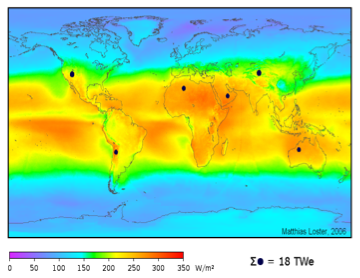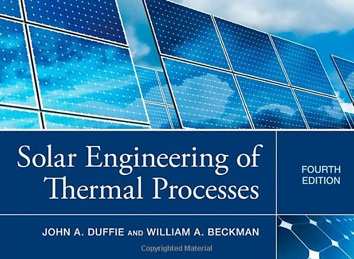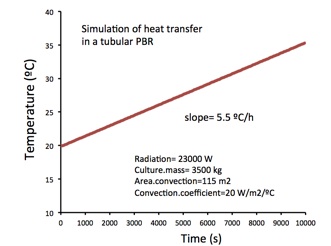5. Heat exchange and head loss.


5.1. Heat exchange. The components of the energy balance.
Heat enters and exits a photobioreactor by several paths. The main heat source is the radiation from the same source that provides light. The environment may supply or withdraw some heat by convective transfer, mainly from the sorrounding air. Evaporation can be also a significant contribution to heat transfer.
These factors can be manipulated in a small extent, so usually, PBRs need some sort of heat exchager. We will quatify the natural mechanisms and the will see how to design a heat exchange.
Solar radiation.
Solar radiation varies over the year and, of course, from day to night. The sun is a very well known source and it is possible to calculate the total intensity reaching any point of the Earth at any time of the year and day. Duffie & Beckman (see the book below) worked out a set the equations to do this
Questions:
-
• Find a correlation to obtain the convection heat coefficient for air moving perpendicullarly over cylinders.
LITERATURE
Solar Engineering of Thermal Processes, 4th Edition John A. Duffie, William A. Beckman
ISBN: 978-0-470-87366-3


The heat flow entering the PBR depends on the intercepted surface (the shadow) and on the amount of albedo. All that is included in Duffie & Beckman's work.
Some properties of the system, such as the reflectance or the albedo, can be difficult to know. So a good advice would be to recommend that you did your own experiment as explained soon
Be warned that some factors afectin the solar radiation are completely random, such as rain od the presence of clouds. But in any case you will have to design to be able to cope with the heat under the worst conditions. If you take a look at the map above you will see that in almeria we have something near 250 W m-2 total radiation averaged over the year and the day. At noon, some clear days radiation may rise to something close to 1000 W m-2. This is the figure to bear in mind.
Convection.
Convection from the sorrounding environment is normally negligible. The convection transfer rate is proportional to the temperature difference:
Where Aext is the PBR area exposed to the sorroundings and Uext is a global heat transfer coefficient. Uext is obtained from the individual resistances (internal, wall, external) but is most times controlled by the external indivicual coefficien. This is Ue=hext. he depends on the especific conditions (wind, exterior temperature, ...etc) and can be obtained by correlations but most often you are likely to find something between 10 al 50 W m-2 unless you are under a tornado or something of the sort.
The energy (heat) balance. Measuring heat input.
In a PBR withour refrigeration, the following energy balance holds:
If the heat loss is negligible, this equation integrates to a very simple form:
Which is a straightforward method to obtain QR. You can estimate QR usin any experimental device and the result for any other will be similar for the same location and time.




Note that if the plot of T vs t is a straight line, that confirms that the heat convective heat loss is actually negligible. This is a commosn situatio shown in the simulation in the figure above. The radiative input of heat is usually much greate that the other sources.


